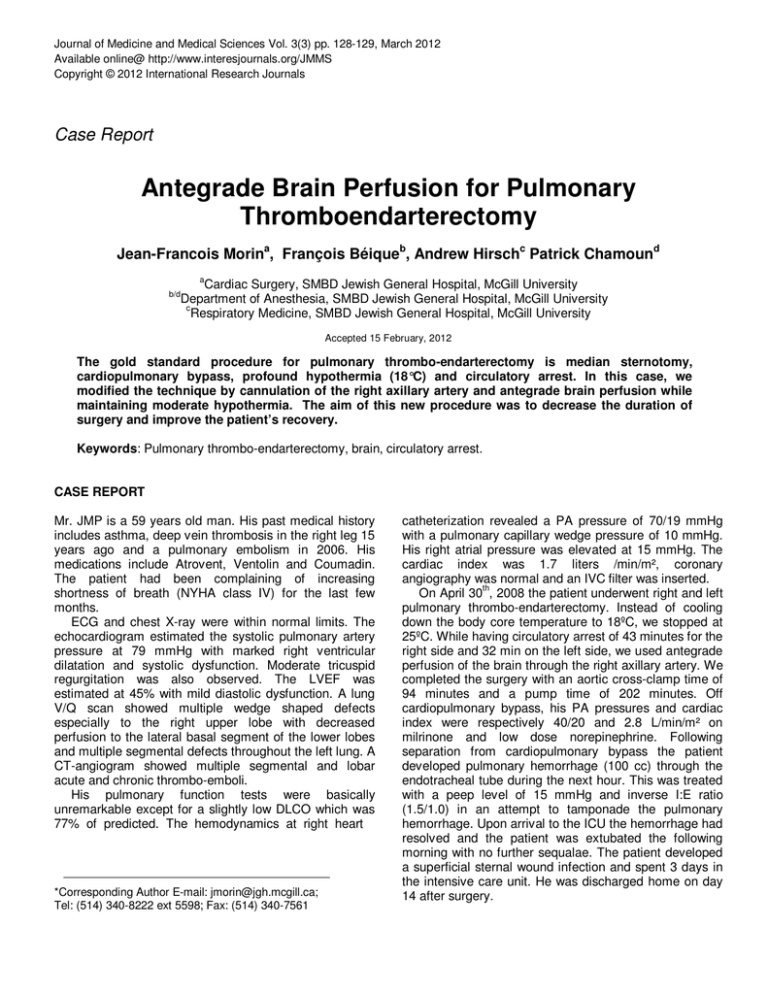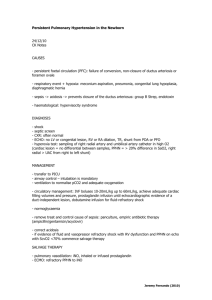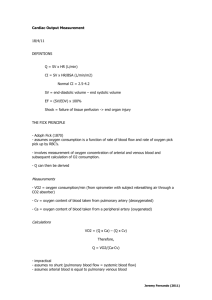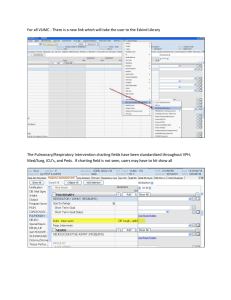Document 14233633
advertisement

Journal of Medicine and Medical Sciences Vol. 3(3) pp. 128-129, March 2012 Available online@ http://www.interesjournals.org/JMMS Copyright © 2012 International Research Journals Case Report Antegrade Brain Perfusion for Pulmonary Thromboendarterectomy Jean-Francois Morina, François Béiqueb, Andrew Hirschc Patrick Chamound a Cardiac Surgery, SMBD Jewish General Hospital, McGill University Department of Anesthesia, SMBD Jewish General Hospital, McGill University c Respiratory Medicine, SMBD Jewish General Hospital, McGill University b/d Accepted 15 February, 2012 The gold standard procedure for pulmonary thrombo-endarterectomy is median sternotomy, cardiopulmonary bypass, profound hypothermia (18°C) and circulatory arrest. In this case, we modified the technique by cannulation of the right axillary artery and antegrade brain perfusion while maintaining moderate hypothermia. The aim of this new procedure was to decrease the duration of surgery and improve the patient’s recovery. Keywords: Pulmonary thrombo-endarterectomy, brain, circulatory arrest. CASE REPORT Mr. JMP is a 59 years old man. His past medical history includes asthma, deep vein thrombosis in the right leg 15 years ago and a pulmonary embolism in 2006. His medications include Atrovent, Ventolin and Coumadin. The patient had been complaining of increasing shortness of breath (NYHA class IV) for the last few months. ECG and chest X-ray were within normal limits. The echocardiogram estimated the systolic pulmonary artery pressure at 79 mmHg with marked right ventricular dilatation and systolic dysfunction. Moderate tricuspid regurgitation was also observed. The LVEF was estimated at 45% with mild diastolic dysfunction. A lung V/Q scan showed multiple wedge shaped defects especially to the right upper lobe with decreased perfusion to the lateral basal segment of the lower lobes and multiple segmental defects throughout the left lung. A CT-angiogram showed multiple segmental and lobar acute and chronic thrombo-emboli. His pulmonary function tests were basically unremarkable except for a slightly low DLCO which was 77% of predicted. The hemodynamics at right heart *Corresponding Author E-mail: jmorin@jgh.mcgill.ca; Tel: (514) 340-8222 ext 5598; Fax: (514) 340-7561 catheterization revealed a PA pressure of 70/19 mmHg with a pulmonary capillary wedge pressure of 10 mmHg. His right atrial pressure was elevated at 15 mmHg. The cardiac index was 1.7 liters /min/m², coronary angiography was normal and an IVC filter was inserted. On April 30th, 2008 the patient underwent right and left pulmonary thrombo-endarterectomy. Instead of cooling down the body core temperature to 18ºC, we stopped at 25ºC. While having circulatory arrest of 43 minutes for the right side and 32 min on the left side, we used antegrade perfusion of the brain through the right axillary artery. We completed the surgery with an aortic cross-clamp time of 94 minutes and a pump time of 202 minutes. Off cardiopulmonary bypass, his PA pressures and cardiac index were respectively 40/20 and 2.8 L/min/m² on milrinone and low dose norepinephrine. Following separation from cardiopulmonary bypass the patient developed pulmonary hemorrhage (100 cc) through the endotracheal tube during the next hour. This was treated with a peep level of 15 mmHg and inverse I:E ratio (1.5/1.0) in an attempt to tamponade the pulmonary hemorrhage. Upon arrival to the ICU the hemorrhage had resolved and the patient was extubated the following morning with no further sequalae. The patient developed a superficial sternal wound infection and spent 3 days in the intensive care unit. He was discharged home on day 14 after surgery. Morin et al. 129 Comment The gold standard procedure for pulmonary thromboendarterectomy is median sternotomy, cardiopulmonary bypass, profound hypothermia (18 to 20ºC) and circulatory arrest. Circulatory arrest is fundamental to provide a bloodless field to remove the thrombi in the affected areas of the pulmonary vasculature for the visibility necessary to clear all affected areas of the pulmonary vasculature (Jamieson et al., 2003). In this case, we modified the technique to improve the brain protection and to decrease the duration of surgery. Cannulation of the right axillary artery for arterial return during cardiopulmonary bypass and for antegrade cerebral perfusion in patients with aortic arch disease has been described by Sabik and colleagues in 1995 (Sabik et al., 1995). Axillary cannulation reduces the turbulent flow pattern in the arch and intra-luminal artherosclerotic debris associated with ascending aortic cannulation (Sabik et al., 1995; Gillinov et al., 1999; Sabik et al., 2004; Hedayati et al., 2004). In aortic dissection surgery the risk of malperfusion is lower than with other cannulation technique and its use has been associated with improved outcomes (Pasic et al., 2003; Moizumi et al., 2005). We are pleased with this modified technique. During the antegrade brain perfusion while on circulatory arrest, the field remains bloodless to perform the meticulous extraction of thrombo-embolic material. In spite of difficult dissection with prolonged circulatory arrest (74 min), the patient woke up without any neurologic deficit. Another advantage of this new technique is to reduce the operative time. By cooling at 25ºC instead of 18 or 20ºC, we reduced the re-warming period. For this first case of a modified procedure, we have been cautious. We limited the decrease in body temperature to 25ºC but perhaps this temperature could have been kept at 28 or 32ºC. Further series are necessary to confirm the safety and good results of this modified technique. REFRENCES Jamieson SW, Kapelanski DP, Sakakibara N, Manecke GR, Thistlethwaite PA, Kerr KM, Channick RN, Fedullo PF, Auger WR (2003). Pulmonary endarterectomy: experience and lessons learned in 1,500 cases. Ann. Thorac. Surg. 76:1457-62; discussion 1462-4. Sabik JF, Lytle BW, McCarthy PM, Cosgrove DM (1995). Axillary artery: an alternative site of arterial cannulation for patients with extensive aortic and peripheral vascular disease. J. Thorac. Cardiovasc Surg. 109:885-90; discussion 890-1. Gillinov AM, Sabik JF, Lytle BW, Cosgrove DM (1999). Axillary artery cannulation. J. Thorac. Cardiovasc Surg. 118:1153 Sabik JF, Nemeh H, Lytle BW, Blackstone EH, Gillinov AM, Rajeswaran J, Cosgrove DM (2004). Cannulation of the axillary artery with a side graft reduces morbidity. Ann. Thorac. Surg. 77:1315-20. Hedayati N, Sherwood JT, Schomisch SJ, Carino JL, Markowitz AH (2004). Axillary artery cannulation for cardiopulmonary bypass reduces cerebral microemboli. J. Thorac. Cardiovasc. Surg. 128:38690 Pasic M, Schubel J, Bauer M, Yankah C, Kuppe H, Weng YG, Hetzer R (2003). Cannulation of the right axillary artery for surgery of acute type A aortic dissection. Eur. J. Cardiothorac. Surg. 24:231-5; discussion 235-6. Moizumi Y, Motoyoshi N, Sakuma K, Yoshida S (2005). Axillary artery cannulation improves operative results for acute type aortic dissection. Ann. Thorac. Surg.; 80 :77-83.




